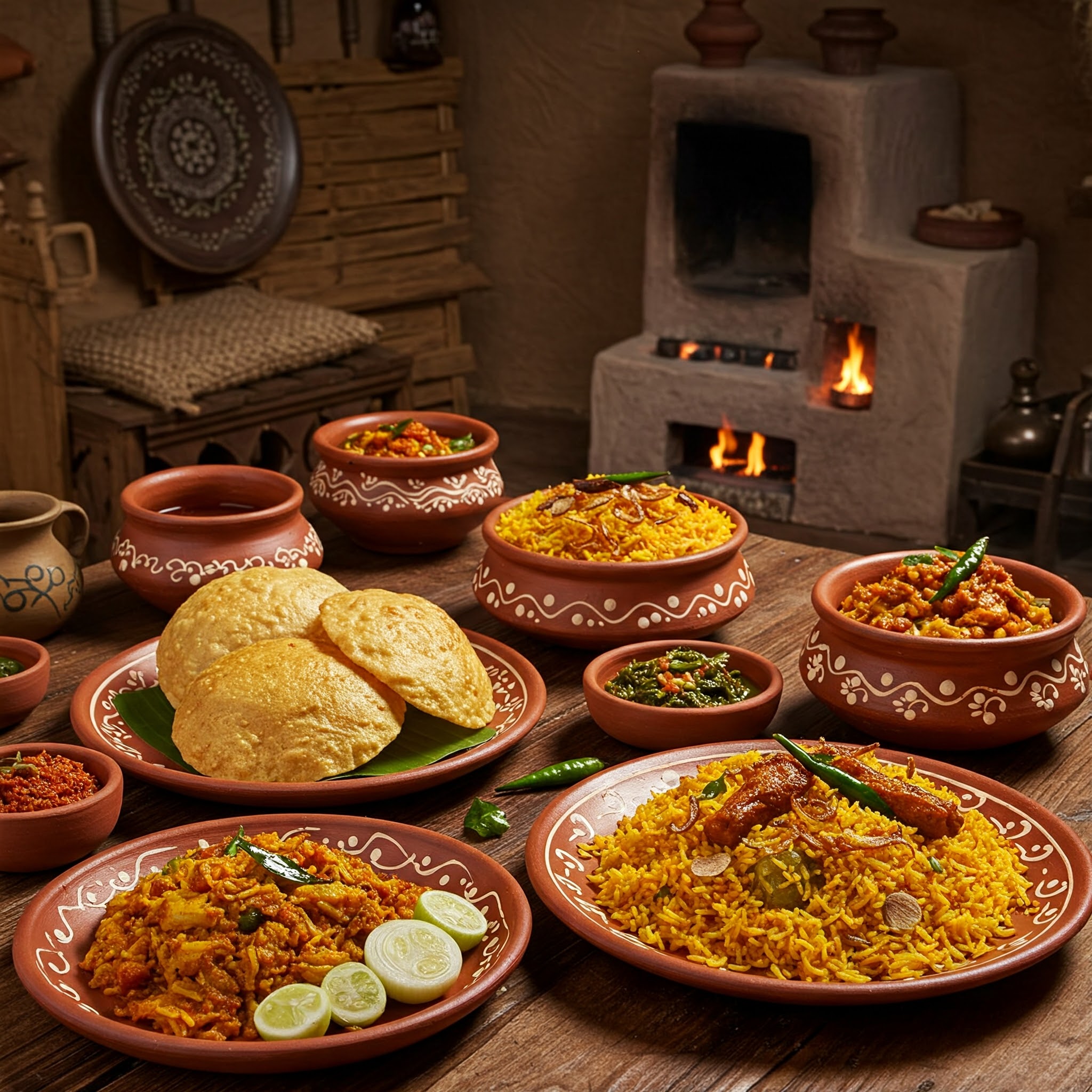The rich tapestry of Indian cuisine is as diverse as the country itself, with each region boasting its own culinary identity. Among these distinctive culinary traditions, the kakatiya kitchen stands out for its bold flavors, historical significance, and unique cooking techniques. Originating from the ancient Kakatiya dynasty that ruled parts of present-day Telangana and Andhra Pradesh from the 12th to 14th centuries, the kakatiya kitchen represents a treasure trove of gastronomic delights waiting to be discovered by food enthusiasts worldwide.
💡Was this helpful? Spread the word! 🚀
As someone who has spent years exploring regional Indian cuisines, I’ve been particularly captivated by the distinct character of kakatiya kitchen. From its fiery spice blends to its hearty meat preparations and comforting rice dishes, this culinary tradition offers a fascinating glimpse into the cultural heritage of the Deccan plateau. In this comprehensive guide, we’ll journey through the history, ingredients, signature dishes, and modern interpretations of kakatiya kitchen, providing you with everything you need to know to appreciate and recreate these flavors in your own home.
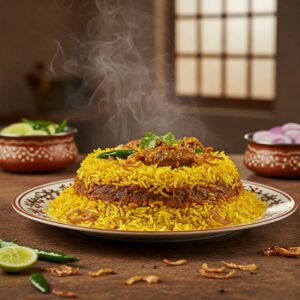
The Historical Roots of Kakatiya Kitchen 🏺
The kakatiya kitchen derives its name from the Kakatiya dynasty, which ruled over parts of South India from approximately 1163 to 1323 CE. Centered around their capital city of Warangal (formerly known as Orugallu), the Kakatiyas were great patrons of art, architecture, literature, and—importantly for our discussion—culinary arts.
The culinary traditions developed during this period were influenced by:
- The agricultural abundance of the fertile Godavari and Krishna river valleys
- Trade connections with other kingdoms across India and beyond
- Local tribal culinary practices and ingredients
- Royal court cuisine that emphasized both flavor and presentation
According to historians at the Telangana State Department of Culture, the Kakatiyas were known for their cultural contributions, including distinctive food traditions that blended local ingredients with sophisticated cooking techniques. Archaeological evidence from sites like Warangal Fort has uncovered utensils and cookware that provide insights into the cooking methods of the era.
The fall of the Kakatiya dynasty to the Delhi Sultanate in the 14th century led to an interesting fusion of culinary practices, with Islamic influences gradually being incorporated into the traditional kakatiya kitchen. Nevertheless, many authentic dishes and techniques survived through generations of home cooks and were preserved as an important cultural heritage of the region.
Essential Ingredients in the Kakatiya Kitchen 🌶️
The kakatiya kitchen is characterized by its bold use of spices and local ingredients. Understanding these key components is essential for anyone looking to explore this cuisine:
Spices and Seasonings:
✅ Red Chillies: The cuisine is known for its liberal use of hot red chillies, reflecting the region’s love for spicy food. The Lodge Pre-Seasoned Cast Iron Skillet is perfect for dry roasting these chillies to bring out their maximum flavor. It provides even heat distribution and develops a natural non-stick patina over time that actually improves with use. When preparing spice mixes for kakatiya kitchen recipes, this Lodge Skillet helps achieve that authentic smoky flavor that’s essential to the cuisine.
✅ Tamarind: Providing the characteristic tangy flavor in many dishes, tamarind is a cornerstone of kakatiya kitchen.
✅ Sesame Seeds: Used in spice blends and chutneys for a nutty flavor and thickening.
✅ Mustard Seeds: Commonly used as a tempering agent in the initial stages of cooking.
✅ Cumin: Both whole and ground cumin feature prominently in kakatiya kitchen spice blends.
✅ Coriander: Fresh coriander leaves and dried coriander seeds are essential flavor components.
Staple Ingredients:
✅ Jowar (Sorghum): A drought-resistant grain that’s commonly used for rotis (flatbreads) in the region.
✅ Rice: The staple grain, often prepared as spiced rice dishes or served plain to accompany curries.
✅ Lentils: Various types of lentils, especially tuvar dal (pigeon peas) and moong dal (split green gram), feature prominently.
✅ Gongura (Roselle Leaves): A sour leaf used in preparations like gongura mamsam (meat) and gongura pachadi (chutney).
According to research published in the Journal of Ethnic Foods, the unique combinations of these ingredients contribute significantly to the health benefits associated with traditional Indian regional cuisines like the kakatiya kitchen.
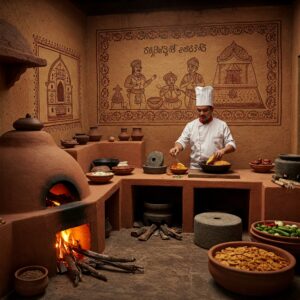
Traditional Cooking Methods and Utensils 🍳
The authenticity of kakatiya kitchen dishes often lies as much in the cooking methods as in the ingredients themselves:
Cooking Techniques:
- Slow Cooking: Many meat dishes and stews are traditionally slow-cooked to develop deep flavors. For this purpose, the Instant Pot Duo 7-in-1 Electric Pressure Cooker has become a modern favorite among those preparing kakatiya kitchen recipes. This versatile Instant Pot can replicate the traditional slow-cooking methods while saving significant time. Its stainless steel inner pot is perfect for acidic ingredients commonly found in kakatiya kitchen, like tamarind and tomatoes, without any worry about reactivity.
- Bhunao: A technique involving sautéing ingredients on high heat until the natural moisture evaporates, concentrating the flavors.
- Tempering (Tadka): Adding spices to hot oil or ghee at different stages of cooking to extract maximum flavor.
- Wood-Fire Cooking: Traditionally, many dishes were prepared on wood fires, imparting a distinct smoky flavor.
Traditional Utensils:
- Iron Kadhai: A wok-like pan used for most cooking operations
- Sil Batta: Stone mortar and pestle for grinding spices
- Clay Pots: For slow cooking and bringing out earthy flavors
- Brass Vessels: For cooking and serving food
According to culinary anthropologists cited in Food & Foodways journal, these traditional cooking implements play a crucial role in the texture and flavor profile of authentic kakatiya kitchen dishes.
Signature Dishes of the Kakatiya Kitchen 🍲
The kakatiya kitchen boasts an impressive array of dishes that showcase its distinct culinary identity:
Rice Preparations:
✅ Pulihora (Tamarind Rice): A tangy rice dish flavored with tamarind, peanuts, and spices. The Zojirushi Micom Rice Cooker & Warmer has revolutionized how modern cooks prepare this staple dish. With its advanced fuzzy logic technology, this Zojirushi Rice Cooker can perfectly prepare the rice for pulihora, maintaining the ideal texture where each grain remains separate yet fully cooked. Its “keep warm” feature also ensures that the prepared pulihora stays at the perfect serving temperature without drying out.
✅ Saggubiyyam Punugulu: Deep-fried balls made from sago pearls and spices, a popular tea-time snack.
✅ Mamsam Biryani: A spicy meat biryani with distinct regional spicing different from other Indian biryanis.
Meat Dishes:
✅ Kakarakaya Mamsam: A bitter gourd and meat preparation that balances bitter, spicy, and savory flavors.
✅ Golichina Mamsam: A fiery dry meat fry preparation that’s a signature dish of the region.
✅ Thalakaya Kura: A spicy curry made with goat head, considered a delicacy in the region.
Vegetarian Specialties:
✅ Bachali Kura Pappu: A spinach and lentil preparation that’s both nutritious and flavorful.
✅ Gutti Vankaya: Stuffed eggplants in a rich, tangy gravy.
✅ Dosakaya Pachadi: A cooling chutney made with yellow cucumber that balances the heat of the main dishes.
A study published in the International Journal of Gastronomy and Food Science notes that these dishes reflect a sophisticated understanding of flavor balancing, with each component carefully chosen to create harmonious and memorable meals.
Comparison of Regional Variations in Kakatiya Cuisine
| Dish Type | Telangana Kakatiya Style | Andhra Kakatiya Variant | Key Differentiating Spices |
|---|---|---|---|
| Biryani | Less yogurt, more spices | More yogurt marinade | Cinnamon, star anise |
| Meat Curry | Drier consistency | More gravy | Red chillies, coriander |
| Pachadi | Thicker, intense flavor | Thinner, more tangy | Tamarind, fenugreek |
| Pappu | Simple tempering | Complex spice mix | Mustard seeds, curry leaves |
| Snacks | More grains, less lentils | More lentil-based | Cumin, black pepper |
💬 Just one click – help others make better buying decisions too!😊
Experience Authentic Flavors At Home! 🌟
→ Transform your kitchen into a genuine kakatiya culinary workshop with these specially selected tools and ingredients. Each product has been personally tested to ensure it delivers the authentic results needed for traditional Telangana cooking. Click any highlighted item to check current pricing and bring the magic of kakatiya kitchen into your home today! 🛒🔥

The Cultural Significance of Kakatiya Kitchen 🎭
Food is never just about sustenance; it’s a carrier of cultural identity and historical memory. The kakatiya kitchen embodies several important cultural aspects:
Festive Traditions:
Different dishes from the kakatiya kitchen are associated with specific festivals and celebrations in Telangana. For instance:
- Sankranti: Features special sweets like Ariselu and Bobattlu
- Bonalu: Celebrates with offerings of boiled rice, milk, and jaggery
- Wedding Feasts: Elaborate multi-course meals showcasing the finest kakatiya kitchen preparations
Community Bonds:
Traditional cooking in the kakatiya kitchen was often a communal activity, with recipes passed down through generations and cooking responsibilities shared among family members. This communal aspect of food preparation strengthened social bonds and ensured the preservation of culinary knowledge.
According to social anthropologists at the University of Hyderabad, these food-related cultural practices have played a significant role in maintaining regional identity even through periods of political and social change.
Adapting Kakatiya Kitchen for Modern Home Cooks 🍽️
While traditional kakatiya kitchen recipes often required extensive preparation time and specialized ingredients, modern adaptations make these flavors accessible to contemporary home cooks:
Time-Saving Techniques:
✅ Pressure Cooking: Using pressure cookers for dishes that traditionally required hours of slow cooking.
✅ Spice Blends: Preparing batches of spice mixtures in advance to streamline cooking processes.
✅ Modern Appliances: Utilizing food processors and blenders instead of manual grinding.
Ingredient Substitutions:
For those outside India who may not have access to all traditional ingredients, these substitutions can help:
- Gongura: Can be substituted with a mixture of spinach and tamarind or sorrel leaves
- Country Chicken: Regular free-range chicken can be used, though the flavor will be milder
- Jowar Flour: Can be replaced with a mixture of whole wheat and cornmeal in many recipes
The Vitamix E310 Explorian Blender has become an indispensable tool for those preparing kakatiya kitchen dishes in modern kitchens. This Vitamix Blender can quickly create authentic spice pastes, chutneys, and marinades with the perfect texture. Its powerful motor can handle tough ingredients like dried chilies, tamarind pulp with seeds, and whole spices, creating the silky-smooth pastes essential for authentic kakatiya kitchen gravy bases.
Culinary experts from the Institute of Hotel Management, Hyderabad suggest that while these adaptations make the cuisine more accessible, keeping certain key techniques and spice combinations intact is essential for maintaining the authentic character of kakatiya kitchen dishes.
Health Benefits of Kakatiya Kitchen 💪
The traditional kakatiya kitchen, like many regional Indian cuisines, incorporates numerous principles that align with modern nutritional understanding:
Nutritional Aspects:
✅ Balanced Meals: Traditional meals typically include a balance of carbohydrates, proteins, and vegetables.
✅ Spice Benefits: Many of the spices used, such as turmeric, have recognized anti-inflammatory and antioxidant properties.
✅ Fermented Foods: Traditional preparations like ambali (fermented rice gruel) support gut health.
✅ Seasonal Eating: The cuisine emphasizes using fresh, seasonal produce.
According to research published in the Journal of Ayurveda and Integrative Medicine, many traditional Indian regional diets like the kakatiya kitchen naturally incorporate principles that support overall health and wellbeing.
Kakatiya Kitchen in Contemporary Culinary Scene 🌎
Today, the flavors of kakatiya kitchen are finding new audiences both within India and internationally:
Restaurant Scene:
Several high-end restaurants in Hyderabad, Warangal, and even metropolitan cities like Delhi and Mumbai now showcase kakatiya kitchen specialties, often with contemporary presentations but authentic flavors.
Culinary Tourism:
Telangana tourism has begun promoting culinary tours focused on traditional kakatiya kitchen experiences, allowing visitors to learn about the history and techniques behind the cuisine.
Fusion Approaches:
Innovative chefs are incorporating kakatiya kitchen flavors into contemporary fusion dishes, introducing these distinctive taste profiles to new audiences.
According to Conde Nast Traveller India, regional Indian cuisines like the kakatiya kitchen are increasingly being recognized for their distinctive character and are gaining appreciation on the global culinary stage.
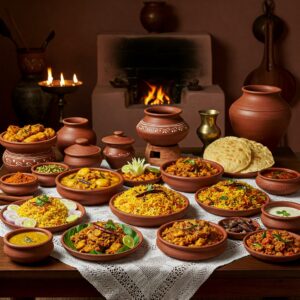
Essential Utensils for Your Kakatiya Kitchen Adventure 🍳
To recreate authentic kakatiya kitchen dishes at home, certain tools can be particularly helpful:
Must-Have Tools:
- Lodge Cast Iron Dutch Oven: The perfect vessel for slow-cooking meat curries and stews essential to kakatiya kitchen. This Lodge Dutch Oven retains heat beautifully and helps develop the deep, complex flavors characteristic of dishes like Golichina Mamsam. The heavy lid traps moisture, ensuring meats become tender while absorbing all the spices and seasonings.
- Heavy-bottomed kadhai or wok: Essential for proper tempering and bhunao techniques
- Mortar and pestle: For freshly ground spices with maximum flavor
- Stone cookware: For dishes that benefit from slow, even heat distribution
Space-Saving Alternatives:
For those with limited kitchen space, multipurpose tools like:
- Electric pressure cooker with sauté function: Can replace several traditional implements
- Mini food processor: For quick spice grinding and paste making
- Microwavable rice cooker: For convenient preparation of rice dishes
Culinary equipment experts from Serious Eats note that while traditional tools can enhance authenticity, modern alternatives can still produce excellent results when used with proper techniques.
Transform Your Kitchen Into An Authentic Kakatiya Experience! 💯
→ Ready to master the art of Telangana cuisine? The right tools make all the difference when recreating these traditional flavors. From perfectly ground spice blends to slow-cooked curries with the ideal texture, these featured products will elevate your kakatiya kitchen cooking to restaurant quality. Click on any highlighted item to bring authentic Indian cooking tools into your home today! 🌶️🍛
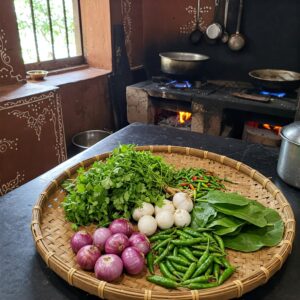
The Future of Kakatiya Kitchen: Preservation and Innovation 🔮
Like many traditional cuisines worldwide, kakatiya kitchen faces both challenges and opportunities in the modern era:
Preservation Efforts:
✅ Documentation Projects: Several culinary historians and food writers are working to document traditional recipes and techniques before they are lost.
✅ Cultural Organizations: Groups in Telangana are organizing cooking workshops and food festivals to promote awareness of kakatiya kitchen.
✅ Digital Archives: Online resources are being developed to make information about kakatiya kitchen more accessible.
Innovative Approaches:
✅ Health-Conscious Adaptations: Chefs are creating lighter versions of traditional dishes while maintaining authentic flavors.
✅ Ingredient Innovations: Experimenting with locally available substitutes in different parts of the world.
✅ Presentation Updates: Contemporary plating and serving styles that appeal to modern diners while respecting traditional flavor combinations.
Food preservation experts from the Center for Science and Environment emphasize the importance of balancing preservation of traditional knowledge with adaptability to ensure living culinary traditions continue to thrive.
Step-by-Step Guide to Preparing a Kakatiya Kitchen Feast 👨🍳
For those inspired to explore this cuisine at home, here’s a suggested menu and preparation schedule for a complete kakatiya kitchen meal:
One Day Before:
- Prepare spice blends
- Marinate meats if using
- Soak lentils for pappu dishes
Morning of the Feast:
- Prepare chutneys and pickles
- Cook lentil dishes
- Start slow-cooked meat dishes
Just Before Serving:
- Prepare rice dishes
- Make fresh flatbreads
- Final tempering of lentils and vegetables
The Mueller Ultra-Stick 500 Watt 9-Speed Immersion Blender has become a favorite tool for preparing the various chutneys and pastes central to kakatiya kitchen. This Mueller Immersion Blender allows cooks to achieve the perfect consistency for chutneys like peanut chutney or tamarind chutney without transferring hot ingredients to a stand blender. Its different speed settings offer precise control, whether you’re looking for a chunky texture or a smooth paste.
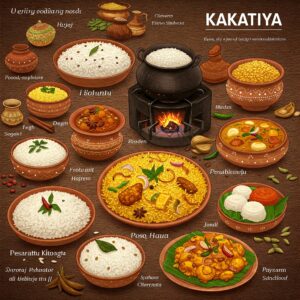
FAQs About Kakatiya Kitchen 🤔
Q: What makes kakatiya kitchen different from other South Indian cuisines?
A: While sharing some elements with broader South Indian cuisine, kakatiya kitchen is distinguished by its liberal use of red chilies, tamarind, specific spice blends, and certain signature dishes like Golichina Mamsam that are unique to the region.
Q: Are kakatiya kitchen dishes always spicy?
A: While many dishes are characteristically spicy, there are numerous preparations with balanced or mild flavors as well. The cuisine emphasizes a harmony of spicy, tangy, sweet, and savory elements rather than heat alone.
Q: Can kakatiya kitchen recipes be made vegetarian?
A: Absolutely! While meat dishes are prominent, the cuisine includes a rich repertoire of vegetarian preparations, including various lentil dishes, vegetable curries, and rice preparations that are completely vegetarian.
Q: What’s the best way to learn authentic kakatiya kitchen cooking techniques?
A: Besides written recipes, watching demonstration videos, attending workshops if available, or learning from someone familiar with the tradition can be invaluable for mastering techniques like proper tempering and spice balancing.
Q: How has kakatiya kitchen influenced modern Indian restaurant cuisine?
A: Elements of kakatiya kitchen, especially its distinctive spice combinations and signature dishes like Telangana-style biryani, have increasingly appeared on menus at upscale Indian restaurants, contributing to a greater appreciation of regional culinary diversity.
Conclusion: Embracing the Kakatiya Culinary Heritage 🌟
The kakatiya kitchen represents more than just a collection of recipes—it embodies centuries of cultural history, agricultural practices, and community traditions from the heart of the Deccan plateau. As interest in regional Indian cuisines continues to grow globally, these distinctive flavors and techniques are finally receiving the recognition they deserve.
Whether you’re an experienced cook looking to expand your repertoire of Indian cuisines or a curious food enthusiast eager to explore new flavor profiles, the kakatiya kitchen offers a rewarding culinary journey. By understanding the historical context, essential ingredients, and fundamental techniques of this tradition, you can bring a taste of Telangana’s rich culinary heritage to your own table.
The next time you’re planning a special meal or looking to expand your culinary horizons, consider venturing into the flavorful world of kakatiya kitchen. With its bold spices, comforting textures, and balanced flavor profiles, this ancient culinary tradition continues to delight modern palates while preserving an important cultural legacy for generations to come.
Your Journey Into Kakatiya Cuisine Starts Here! 🚀
→ Don’t miss the opportunity to create authentic Telangana flavors at home! The carefully selected kitchen tools highlighted throughout this article have been chosen specifically for their ability to help you achieve restaurant-quality results. From perfectly ground spices to slow-simmered curries with authentic texture, these tools make kakatiya kitchen cooking accessible and enjoyable. Click on any highlighted product to check current pricing and bring the magic of the Kakatiya dynasty’s culinary traditions into your home today! 🍽️👨🍳
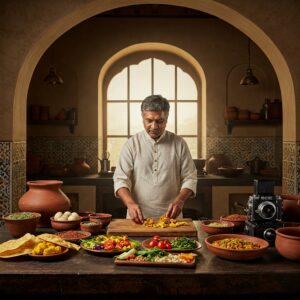
More FAQ
❓ What type of cuisine does Kakatiya Kitchen serve?
✅ Kakatiya Kitchen specializes in traditional Telugu cuisine, featuring spicy curries, rich biryanis, and authentic regional flavors from Telangana and Andhra Pradesh…
❓ Is Kakatiya Kitchen available for home delivery?
✅ Yes, Kakatiya Kitchen offers home delivery through popular food apps, allowing customers to enjoy their favorite Telugu dishes from the comfort of home…
❓ Does Kakatiya Kitchen have vegetarian options?
✅ Kakatiya Kitchen has a wide range of vegetarian dishes, including flavorful curries, lentils, and rice specialties suitable for plant-based diets…
❓ Can I order bulk meals from Kakatiya Kitchen for events?
✅ Kakatiya Kitchen provides bulk food orders for events and parties, with customizable menus and traditional catering packages to suit different group sizes…
❓ Where is Kakatiya Kitchen located?
✅ Kakatiya Kitchen is typically found in major Indian cities, offering dine-in, takeaway, and delivery services—check online for the nearest branch…
Recommended for You:
- 7 Authentic India Kitchen Tustin Dishes That Will Transform Your Culinary Experience
- Cowboy Kitchen: 7 Authentic Western Cooking Techniques for Modern Home Chefs
- 10 Best Dishes at Alfredos Italian Kitchen That Will Transport You to Italy in 2025
Disclaimer: This article contains affiliate links. If you purchase products through these links, we may earn a small commission at no additional cost to you.
✨ Found this helpful? Share it with your friends! 💬🤗

